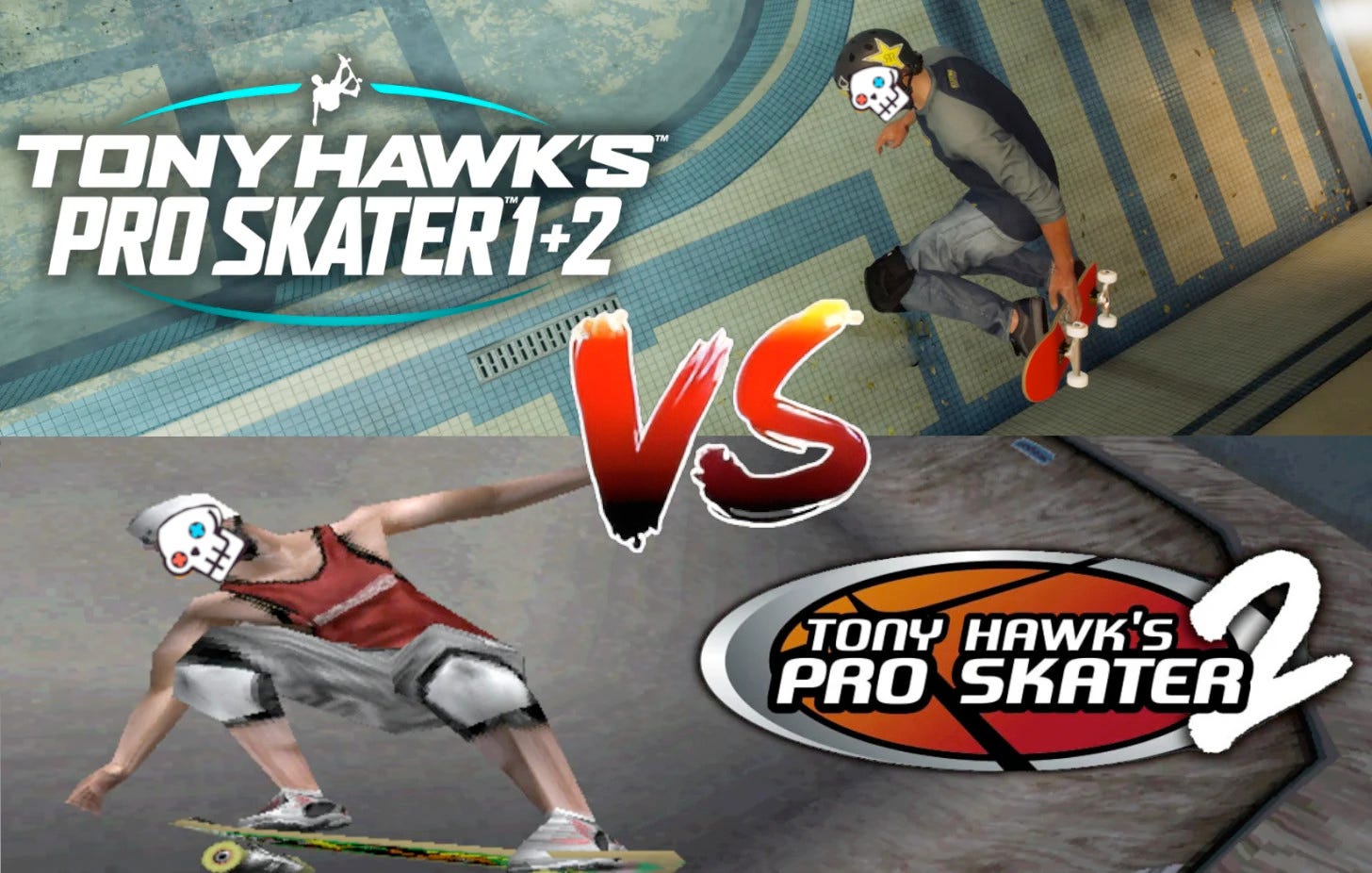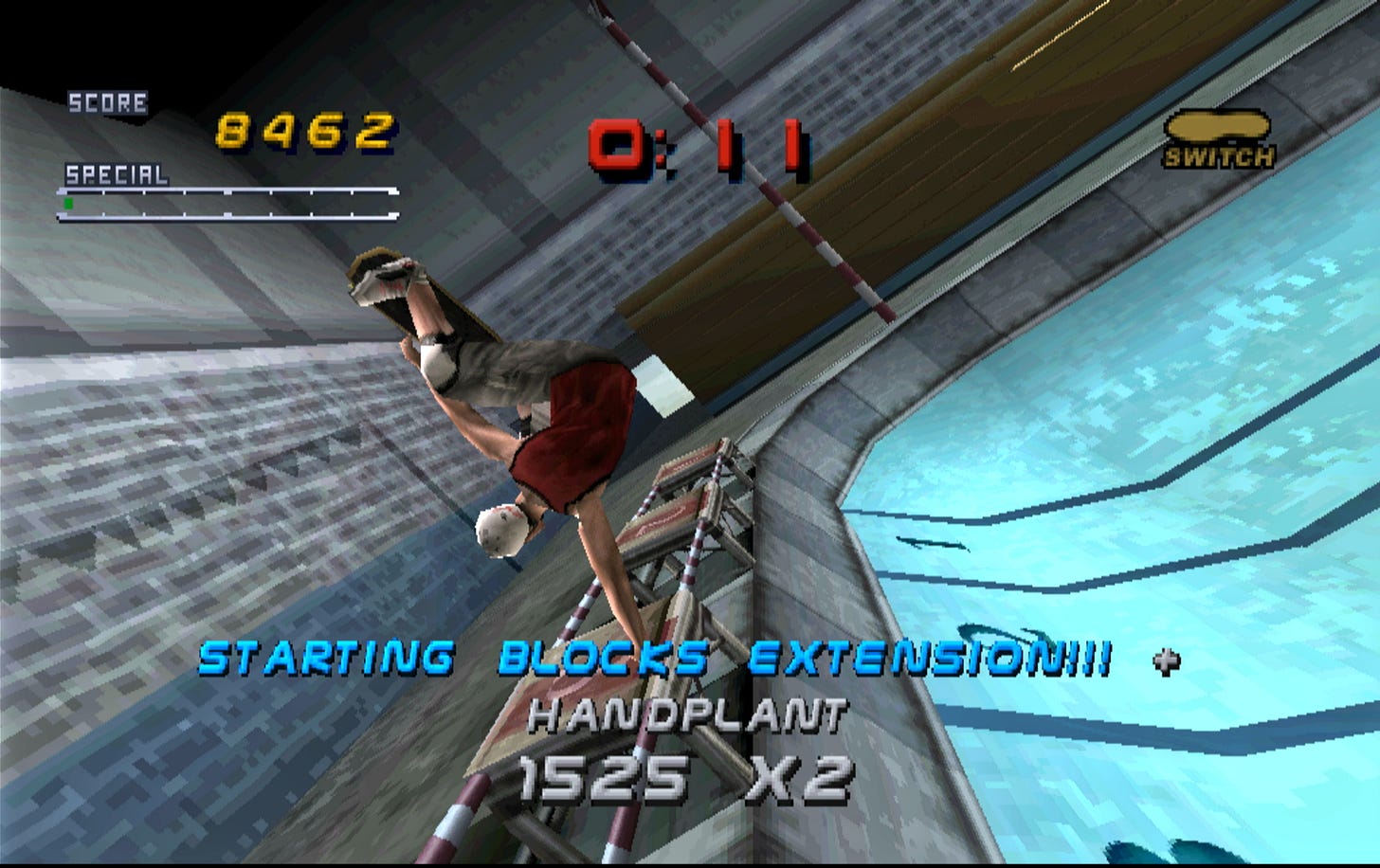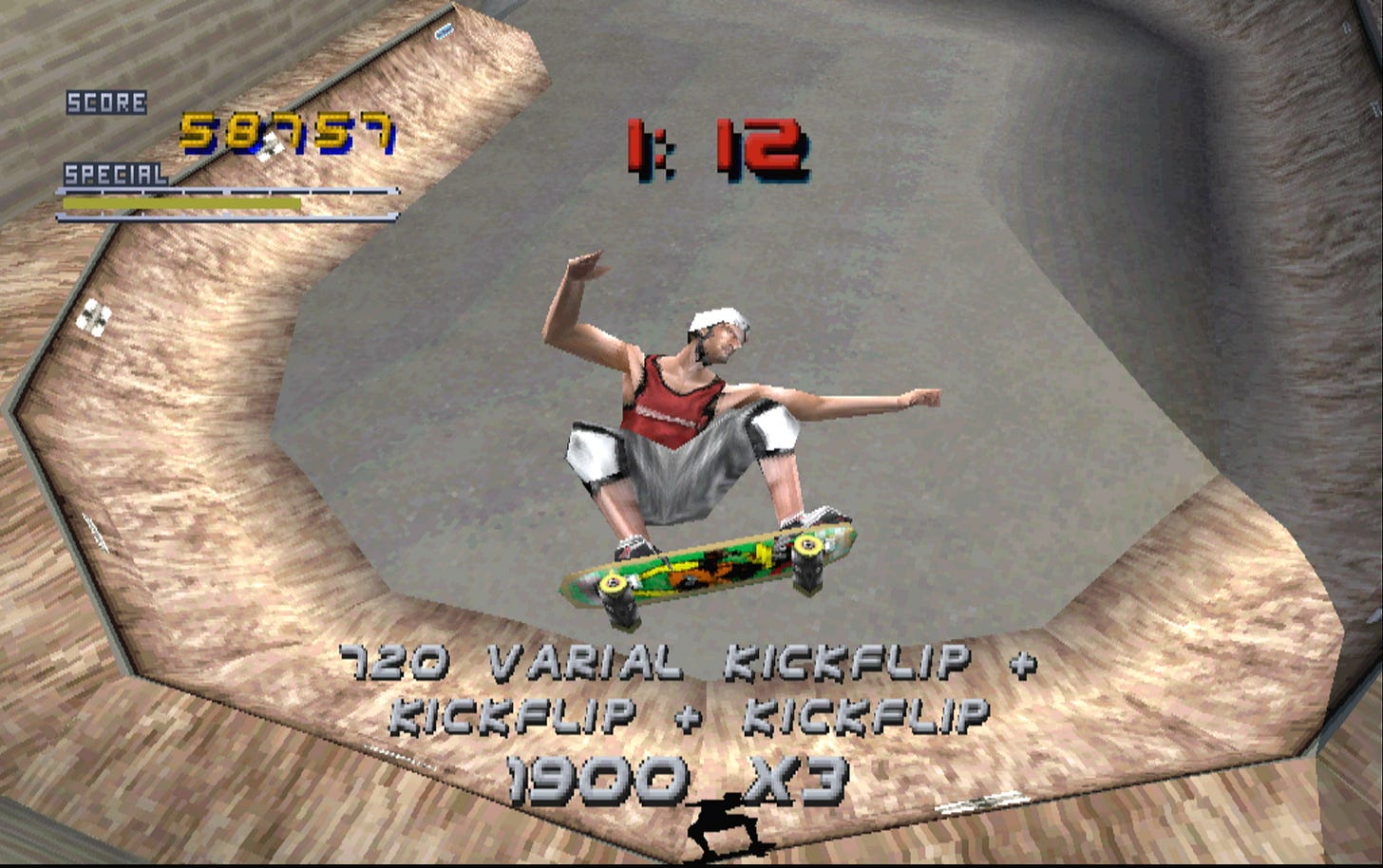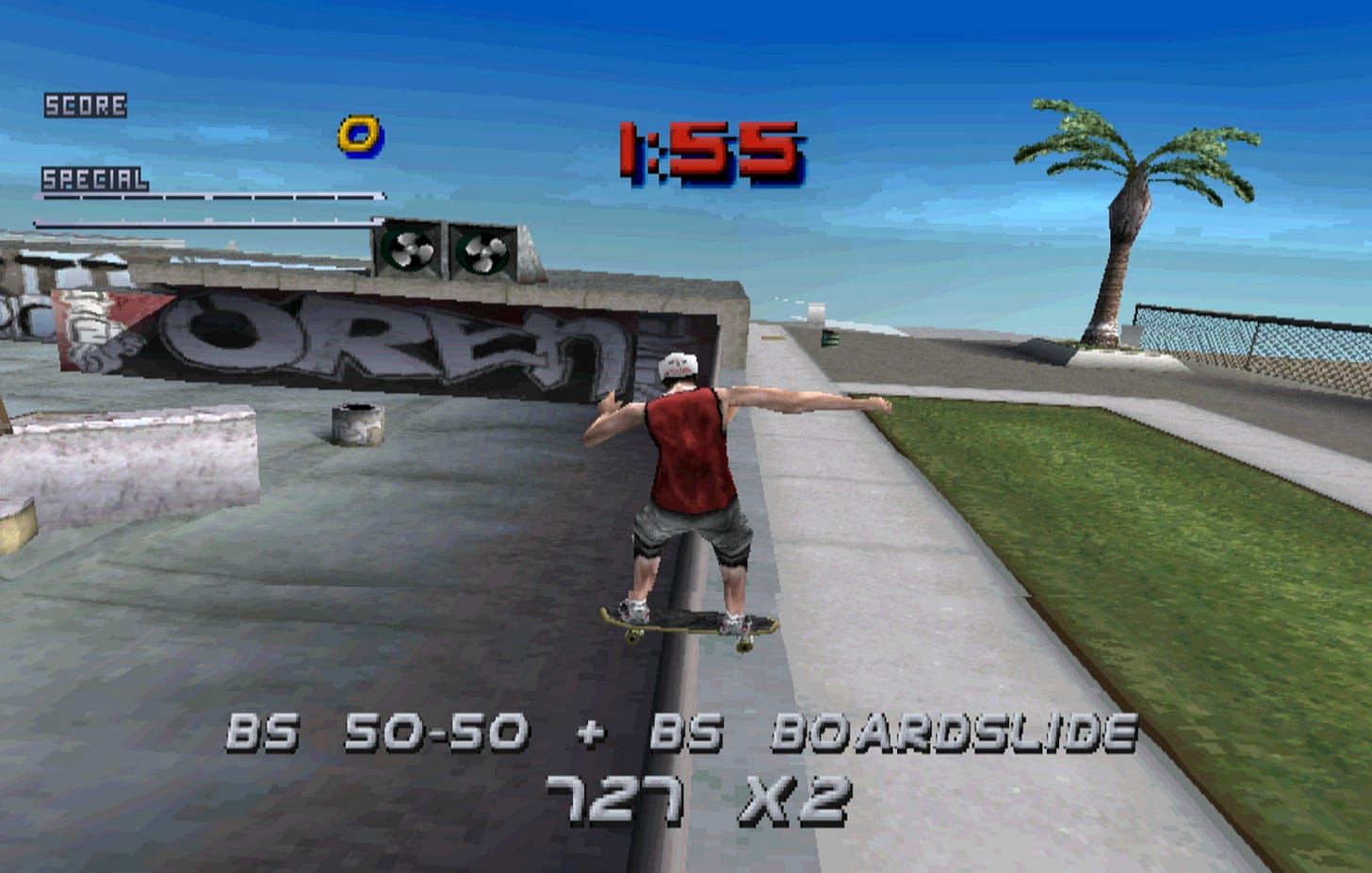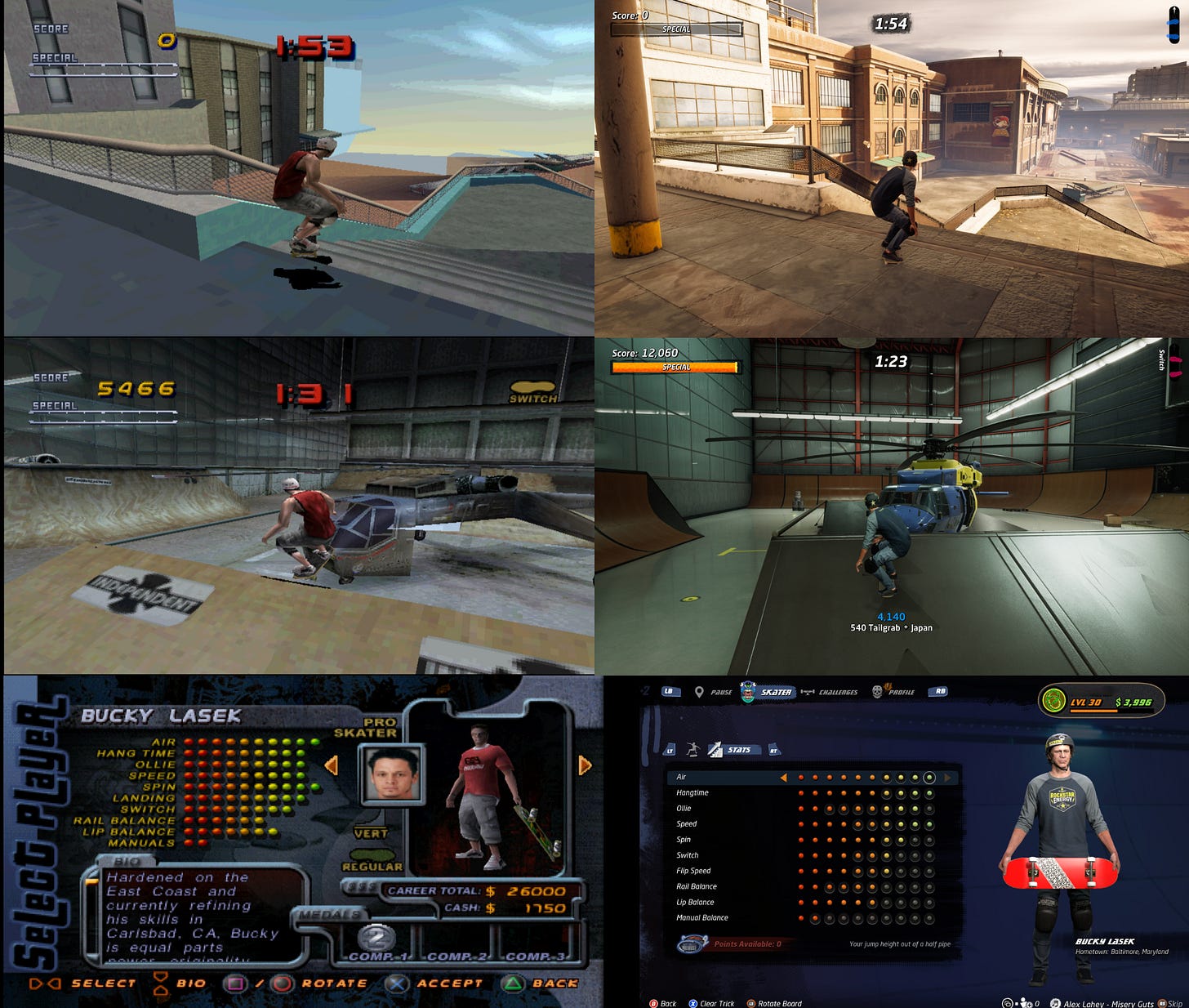Big Read: Tony Hawk vs Tony Hawk
Nostalgia and modernity clash as we pit PS1's immortal skateboarding game against its recent HD remake.
If we learnt anything from 2015’s universally traumatic remake of Point Break, it’s that some 90s icons should be left the f**k alone. So when it was announced in 2019 that developer Vicarious Visions would have a crack at remaking the PlayStation 1’s classic Tony Hawk’s Pro Skater 1 and 2 games, there was genuine concern.
Could it work? Or would this, the third studio to develop the franchise, pull a Point Break on a beloved millennium-era classic? But like the OG Bodhi said while smouldering on the beach in the 1991 cinema classic, “If you want the ultimate, you gotta be willing to pay the ultimate price.” Failure with this high-stakes entry could mean the death of the series, or worse, banishment to the deep waters of mobile gaming.
It was time to seek my own answers. Vicarious Visions released Tony Hawk’s Pro Skater 1+2 on consoles and PC back in 2020, so I was already four years late dropping in on their nostalgic remake. But I needed to know the truth.
However, before seeking this knowledge there was something I knew I had to do. Something it’s advised never to do. I had to revisit a former love.
And so it was I spent a week back on the board of the 2000 PS1 classic Tony Hawk’s Pro Skater 2, before committing the same time to 2020’s new-skater-on-the-block Tony Hawk’s Pro Skater 1+2. This was the only way to truly know if the sharper graphics, controls and modern conveniences of the modern remake would be enough to improve on a sports game GOAT, or if gamers are better off keeping it real and retro with the original.
But why THPS 2 and not the first, OG, Tony Hawk’s Pro Skater 1? Well…(Fade to flashback mode)
It was 2000, and we all thought baggy jeans and glacial downloading of rad po-punk tunes on Napster, would last forever. PS1 consoles were spinning disks everywhere, and THPS 2 was the game. Kids that got no air under their ollie in the street were pulling 720 Judo Air to Misty Flip in their lounge rooms.
The first THPS game hadn’t had this same impact, but the sequel arrived less than a year later, rounded off the rough edges of its predecessor and went on to sell over 3 million units worldwide. Despite being late in the PS1’s tenure — its much-hyped successor, the powerhouse PS2, was released just two months later here in NZ — THPS 2 was a raging success and was ported to everything from the Dreamcast to the Macintosh, ultimately taking an immortal place in gaming history
Tony Hawk’s Pro Skater 2 - PS1
“There’s a place where everyone can be happy” - Bad Religion
Fast forward 25 years and once again the start-up dramatics of Rage Against the Machine’s Guerrilla Radio blares from my TV. Controller in hand I’m back in career mode, at the Mullet Falls Hanger, as a bone stock skater. It’s time to earn some big money. Well, a few hundred bucks anyway.
So do the graphics hold up? Not exactly. No PS1 game can visually compete with modern offerings. It’s blocky, the backgrounds are flat with shallow draw distance, and there’s a lack of detail. But the gameplay, the controls, the visceral feel of the game, that holds up entirely.
There’s a gripping pace of progression in THPS 2 career mode. Achievements and unlocked levels come quick at first and then slow down once you’re hooked. During the week, I never got fully stumped, but I hit some familiar sticking points. Acquiring the secret videotape remains as much fun as rubbing grip tape on your nuts. The skate competitions offer a break from the level unlocking and upgrading, with a different structure and an opportunity to show off your advancing skill set.
The controls were so precise and tight for the time and you can still feel that fluidity playing today. The more time you spend on the pad, the less you think about each button press and the more it becomes feel and flow. I often found myself looking forward to my next session on THPS 2, and I can’t say the same about many newer games I’ve played. Also, there is strong replay value with difficult challenges, gaps to find and master, and various customisations.
THPS 2 is a game with a broad array of single and two-player modes and discovering what works is part of its charm. Back in the day, I remember playing with mates and once everything was unlocked and a skater’s abilities were maxed out, we simply passed the controller for 2-minute runs, each chasing a place on the scoreboard. It was a one-player approach that also worked for a group, with the soundtrack cranking and a chance to kick back and throw shade on each other’s runs and trick selection. It also showed the game’s capacity for self-expression and differing styles.
Class is permanent, and a great game is always going to be a great game. THPS 2 is a rare breed that transcends genre and is greater than the sum of its parts. Just like Point Break is still awesome to watch today despite being over 30 years old, THPS 2 can offer gnarly treats on the gamepads. Visually, the game’s advanced age is always present but that’s easy to forgive once you get flipping and grabbing. It’s not perfect, the fixed camera view can be frustrating, but perfection isn’t required to be a masterpiece.
Perhaps what’s most special about playing THPS 2 in 2025 is its ability to return the player to the year of its release, 2000, without a requirement for individual nostalgia. The music plays a large role here, and licensed music was still a mostly unexplored part of gaming back then. Also contributing are the skater’s clothing, the FMV, level scenery, menu screens and fonts, and even the humour. I must confess to seeking some online assistance to finish some challenges, but finally finding those answers after all these years was a treat in itself. In 2000, even once the home phone was free, hints and tips weren’t easily available by surfing the World Wide Web.
How far did I get in career mode after a week? Well, I’d love to say I was kicking ass on the final standard level, the Bullring, but I fell just short. I’d made it to Philly, taken medals in the first two comps, bought some tricks and upgraded old Bucky Lasek to near bursting point. A couple sessions more and I’d have career mode almost beat. I’d shredded hard and since I was to do it all over again in a more modern guise, It was time to tic-tac away and ollie into the future.
The series had grinded the remake-rail before with 2012’s Tony Hawk’s Pro Skater HD, released on PC, Xbox 360 and PS3. But with it no longer available for download, and no physical copies produced, it’s trapped forever inside a few old hard drives. So I went to Steam, gave them NZD$20, hit download and soon enough I was ready to drop in once again.
Tony Hawk’s Pro Skater 1+2 - PC
“Out with the old in with the new” - Alley Life
Firstly, it looks absolutely gorgeous. I mean, of course, it was going to appear strongly updated, but THPS 1+2 is visually fantastic. Take a Tony Hawk player from 2000, time travel them 20 years into the future to play the remake and it wouldn’t disappoint. There’s an elegance to the lighting across the levels. The street lights and shadows of New York, fluorescents in the hanger, and the sunset at Venice Beach - lighting is a strong aesthetic feature. Artistically, there’s greater realism and a keen tribute paid to 90s-era skateboard graphics and artwork, albeit in high definition.
I found my boy Bucky and we set off on a fresh career. He sucked in standard form before I upgraded his stats, but I was loving the refreshed hanger so much his lethargic spins and lack-of-speed didn’t matter. Much of the magic in playing the remake is revisiting the level locations, and it honestly feels like you’re returning after 20 years. Some, like the hangar, are modernised. Others like School 2 are visibly older. Marseille has been updated to be an exact likeness of the French skate park as you’d visit it today. The ability to add extra graphic detail has been used thoughtfully. Despite the surface changes. The ramps, rails and obstacles are all waiting in the same spot they were in 2000. For nostalgic gamers, it can be an emotional journey.
The time-limited arcade approach works just as well now as it did 20 years ago and there’s been a massive expansion in challenges beyond just the level challenges. These are achieved in a broad manner of ways but many come by performing specific tricks or a quantity of tricks across different levels. There are also secret challenges, bonus novelty skaters to unlock, and speed runs where you race through a level hitting all the standard goals.
But where’s the fire, young Thundercats? It’s nicer to take your time, reminisce and cross out the level goals one by one. Stop and huff the spray paint.
In between smashing out levels you can visit the skate shop where there’s been a huge extension to skate shop merchandise for your custom skater, there’s a massive selection of boards and other equipment, shoes, $50 designer socks, clothes and even garish tattoos. Excessive? Yes. Detracting? Not really, it’s easy to no comply here if you’re not interested.
Cash is dated, so earning it is out. Now grabbing stat points positioned on the levels is in, as is earning XP experience points to level up your skater. Rather than being used and locked in, the all-important stat points can now be shifted around to improve your chances of completing specific goals and challenges, where you may need more speed or a higher ollie. This proved a helpful feature.
In terms of achieving level goals everything just came a little easier than the original game. In part, I put this down to the more precise controls. THPS 2 controls were excellent for the time, but they can’t compete with newer controllers and, the fine-tuned accuracy of a game 20 years junior. But you also have to wonder if some of the goals have been made slightly easier to appeal to younger gamers, who may not remember the days when frustration and white-hot rage were an expected part of the gaming experience. Back then, did you really love a game without first wanting to throw it against the wall?
An example of the remakes easier ride came on the School 2 level and the ‘Wall Ride 5 Bells’ goal. On the original this is awkward. The skater’s ollie has to be the right height, speed and angle to first wall ride correctly, and also hit the bell - five times in the limited time. I must have taken over 20 runs to complete that goal. On the remake, I completed it first time. It’s also noticeably easier to ollie up to higher areas in the remake. However, the competition levels are still tough and, like the original, you’ll often finish just outside of the medals.
The sequel also offers ‘Game Mods’, which could also be called ‘Cheats for Big Babies’. These include ‘perfect balance on rails’ and ‘no bails’. It’s not right and not what Tony Hawk’s is about. Even our youngest gamers should be learning the hard knocks way. At least the developers had the decency to prevent players using these mods from recording leaderboard scores.
One small kindness the remake has, that I’m all for, is a small boost of speed as you respawn after a wipe-out. This means you’re not as static going into your next trick attempt. In the original, a harsh bail in the wrong spot could ruin an entire run. All up on THPS 1+2, I did go further into career mode faster than THPS 2 and was scoring medals at the Bullring by the end of the week.
There are some nice modern conveniences like auto-saving and one-button skipping of the music track. If you really hate a song you can remove it entirely from the playlist. There are 22 legacy tracks and 37 new, and at first I was anti-the new tracks. But I’m glad I left them in the rotation because a few grew on me, and discovering new music was one of the coolest parts of playing the earlier games. The game also recognises the importance of flow during your run, and the part music plays in that — the song volume increasing when you’re crushing it and decreasing when you’re actually crushed at the bottom of the half pipe. The music volume does need to be adjusted up a notch for it to feel the same as THPS 2. There are also options around controls and you can elect a move-set from the first or second game, mostly depending on your feelings on manuals, reverts and overall authenticity.
How faithful does it stay to the OG? A little emotional cheating, but pretty loyal overall. That same spirit of rebellion from the original remains, with a couple of caveats. There’s no blood when you hard bail in the new version (boo!) and there’s been some censoring on the songs to remove swearing (double f’kn boo!). There’s also a small nod to commercialism with an indulgent Vicarious Visions logo to be found on every level. But none of this takes much away from the playing experience.
If you choose to push on after the remake’s THPS 2 campaign, you can move into THPS 1, or vice versa, with your same high-stat skater, to blast through the level challenges and earn more stat points to max them out completely. For me, this proved too tempting and I continued into the THPS 1 career mode, seeing those levels and crossing out their goals for the first time. I’d also left behind a few hidden levels to unlock, so another week of gaming was gonna be required here.
Score Sheet
"I'm the ambassador of Kick-Your-Assador” - The Vandals
What playing both games back-to-back highlights most is just how good THPS 2 still is, despite its 25-year age. You’d be hard-pressed to find a game from the fifth-gen console era that holds up better. Many gamers might not realise that THPS 2 has been living in their hearts all these years till they dust it off and go again.
After a week with THPS 2, I was still grinding to reach the Bullring. I’d spun the future rot off that disk to get that far too. By comparison with the remake, I’d 100% completed most of the levels and took a silver medal at the Bullring on my first attempt. For what’s a generally faithful remake, the difficulty settings of the two games aren’t matched accurately.
So can a remake game ever exceed its original source content? The game that it owes its very existence to? The answer is… not really. In the same way that the Point Break remake was never going to leave people claiming it was better than the original. The source content is both gift and curse.
THPS 1+2 has improved the graphics and controls, and even expanded on some concepts. But it can’t regenerate the surrounding mood of the time when the original was released. THPS 1+2 could never share the impact Tony Hawk’s Pro Skater and its sequel had when it reached the Playstation 1 and our old CRTs. This doesn’t detract from it as a free-standing game, it just makes its reception relative to the human with the controller in hand. Anyone born this century will take a quick look at both games and quickly tell you which is technically better.
But for those who were there to play the original - it’s not that simple. What’s cool is that the developers knew this and created THPS 1+2 with a sensitivity and an awareness of the maturity of those it would mean the most to.
At Pixel Fix, we’re about gaming experiences, and grinding some THPS 2 before hitting up its future-self, was some A-grade gaming time. They are the same game in many ways, but each offers a different experience. I’d recommend playing the original first and then the new, as it’s jarring in reverse.
If you want to keep it real and spin discs, the PS1 version of THPS 2 is creeping up in price, currently around NZD$50 for a good condition used copy with manual. Cheaper if it’s platinum, black label or disk only. But regardless, any righteous PS1 collector needs a copy.
THPS 1+2 is much easier to possess, I played on PC via Steam download, but used physical copies are available for Playstation 4 and 5, Xbox and Nintendo Switch.
For many gamers around since Tony Hawk’s started, the franchise peaked early with the first three Pro Skater titles. Over the years, there have been 21 Tony Hawk’s games in total, 18 between THPS 2 and its remake. There were hits and misses, we went underground, downhill, to the wasteland, and even some gnarly peripherals.
Now, with the return to form of THPS 1+2 there must be no doubt left that this original format works best. The franchise needed to return to the beginning to achieve contemporary success. Hopefully, that’s a wake-up call to those in charge. Blizzard, you’re at the wheel now. We may just be ageing gamers, reliving glory days, but take what you’ve learned with THPS 1+2 and blow us away with a new Pro Skater 6. Or at least follow up with a remake of 3+4.
Go on, bring the noise.






